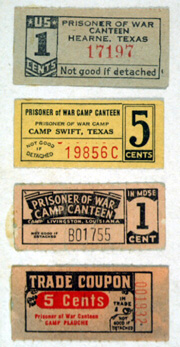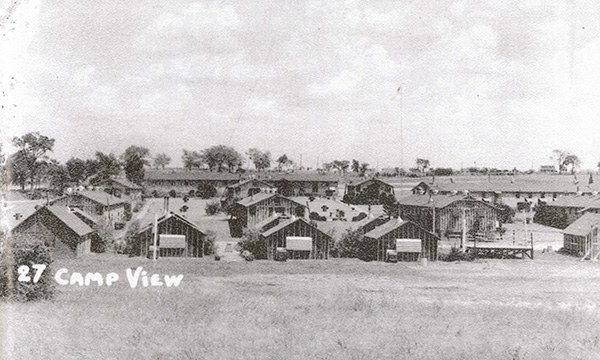
German prisoners of war enter a train car at Mexia in Texas. Some 200,000 German P.O.W.s were housed in Texas from 1943-45. Below, German P.O.W.s were paid 80 cents per day in canteen coupons. (Images courtesy of the Friends of Camp Hearne)
About 300 Germans were housed near Winfrey point from 1944-45
When Gen. Erwin Rommel’s Afrika Korps fell to the Allied Forces in May 1943, the United States had to figure out what to do with hundreds of thousands of prisoners of war.
Some were sent to Mississippi and elsewhere in the South, but most came to camps in Texas. Our state had plenty of space for the prisoners, and the weather here is similar enough to Northern Africa. A 1929 Geneva Convention rule states that prisoners of war must be housed in similar climates to those from which they are taken.
As many as 200,000 German prisoners of war were housed in Texas from 1943-45, and a few hundred of them were imprisoned at White Rock Lake.

For their work in the shop, the Germans earned 80-cents a day, paid in canteen coupons.
The U.S. Army had built barracks near Winfrey Point for the Civilian Conservation Corps in 1935. Dozens of otherwise impoverished American men ages 18-24 lived in the barracks and worked for the conservation corps, earning $40 a month, of which $22 was sent directly to their families. The corps built many of the lake’s amenities, including Sunset Inn, the picnic area at Flagpole Hill and the Big Thicket building. The Corps also installed concrete bollards around the lake, which are still in use today; it began construction on the Winfrey Point building before the United States entered World War II and the Conservation Corps program ended.
After the fall of the Afrika Korps, thousands of German prisoners were brought to Mexia, 85 miles southeast of Dallas, and housed in new buildings. The old Conservation Corps barracks at White Rock were used as overflow housing for the crowded P.O.W. camp at Mexia.
About 300 German soldiers were housed at the lake from 1944-45. Their first task upon arrival was to build a security fence topped with barbed wire and guard stations surrounding the barracks, according to Sally Rodriguez’s 2010 book, “Images of America: White Rock Lake.” Their barracks, just a few feet from Garland Road, were guarded day and night by U.S. Army soldiers.
Every night, the Germans were taken by bus to Fair Park, where they worked a third shift at a repair shop. The Army quartermaster shop repaired uniforms, shoes, helmets, tents and other equipment. At its peak, the shop employed 707 civilians in two shifts; 614 were women, more than 60 percent of whom were the mothers of United States servicemen.
For their work in the shop, the Germans earned 80-cents a day, paid in canteen coupons.
No prisoners ever escaped from the White Rock camp, but escapes were reported at some of the dozens of other camps in Texas, particularly from camps in Mexia and Hearne. All of them were quickly recaptured. A 2012 story from the History Channel reported that most German prisoners were content to stay in the camps because they were well fed and had relative freedom and peace, compared to the warring in Europe. Most of the escapes were thought to have been due to the boredom of young men looking for women and booze, according to the Texas State Historical Society. The accommodations at White Rock were particularly comfortable compared to other Texas P.O.W. camps, where prisoners were housed in old Army tents and even circus tents.

A view of the Civilian Conservation Corps barracks at White Rock Lake, which were built in 1935 and later used to house German prisoners of war. (Photo courtesy of “Images of America: White Rock Lake” by Sally Rodriguez)
Members of Congress and the American public expressed displeasure at the relatively luxurious conditions for German prisoners, who played soccer, were given art supplies and received educational opportunities, lax punishments, plenty of food and even beer in some places. The camps were derisively known as the “Fritz Ritz.”
When the war ended in 1945, the Germans were sent to Europe, 50,000 at a time, to help with efforts to rebuild in England and France before being shipped home.
The Dallas Parks Department regained control of White Rock Lake from the Army in 1946. The quartermaster repair shop at Fair Park closed the same year.
Starting in 1946, the barracks were used to house about 200 military veterans enrolling at SMU under the G.I. Bill.
The Mexia camp became what is now known as the Mexia State Supported Living Center. The camp in Hunstville is now a golf course. In Hearne, the old camp has been partially rebuilt and is a museum related to Texas’ prisoner of war camps during World War II.
All that’s left of the Dallas encampment today is an old fire hydrant amid the grassy prairie of White Rock Lake.
—Rachel Stone





